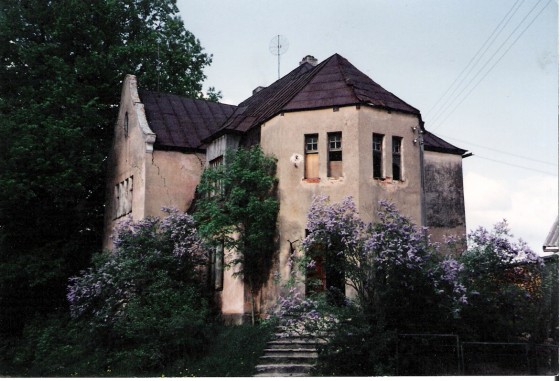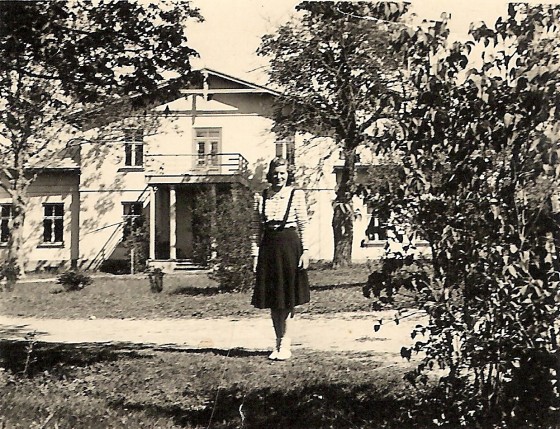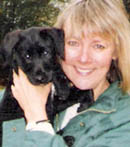This is a story about a house, a rather special house and about what happened to it, most specifically since the year 1991 when Latvia regained its independence. The house has style and is somewhat stately as far as private country homes go. It sits on a hill in the picturesque town of Alūksne in Vidzeme.
My maternal grandfather, Jānis Krēsliņš, built this house before the First World War after his first house was burned to the ground by angry tenants ( who were in fact friends squatting for free). The buddies had been told to leave since my grandfather was getting married and needed the house for his family. To spite him the freeloaders burned down the house.
The new house stands on the corner of Jāņkalna and Lielezera streets and overlooks the town of Alūksne. From its windows can be seen beautiful Lake Alūksne in the distance.
As a journeyman perfecting his craft of master artisan in ceramics, my grandfather had traveled extensively and his vision for his home was influenced by the stately homes of Germany.
Work on the house began in 1909 but the First World War intervened before it was finished. Much of the War and the immediate aftermath, my grandfather spent in hiding from the Communists. He was considered wealthy since he was a master potter and tile stove setter. His wealth consisted mostly of IOUs and my grandmother, Johanna Krēsliņš (nee Hermanovitch), taught sewing to make ends meet. Since my grandfather had no business skills it was up to my grandmother to sell pottery and run down the debtors. As soon as the children (including my mother) were able, they were put to work in the pottery. My mother as a little girl was also hired out as shepherdess of a small herd of cows.
During Latvia’s War of Independence in the wake of WWI the house became the headquarters for the Finnish officers who were stationed in the garrison. After Latvia finally became independent in 1920 the country flourished. Yet my grandparents struggled on. My grandfather, who was always generous with his friends, seemed to forget that his family came first. My grandmother, who also was extremely kind and generous, did put her family first. The family was quite large and included her sisters and brothers. Her priority was to finish the house for the extended family and she managed to save enough money for work to continue.
In addition to the original pottery my grandfather built a new pottery which included workshops fully equipped with the best tools money could buy for his nephews. One was an electrician and the other a cabinet maker. Exploiting my grandfather’s generosity neither one ever paid a centime in rent or repaid him for the tools.
In 1936 calamity struck again when my grandfather died. My grandmother was left to struggle on alone. Difficulties mounted. The workers in the pottery, who had already been stealing from my grandfather when he was ill, walked out because they did not want to work for a woman. The only potter my grandmother could get was a Jewish convict who had murdered his wife when he had found her in bed with someone else. Money was very scarce. To sustain her family my grandmother was forced to rent out rooms in the house.
Then came World War II. My grandmother was put out of her own house when the Communists occupied Latvia and the Communist party members put in proletarian tenants/squatters.
Thus began the destruction of the beautiful old house. The Communist government decided to straighten Jāņkalna Street. As a result, the foundation of the house was exposed and undermined.
But the house was so well built that it took another fifty years of willful neglect to bring it to its knees. Major acts of vandalism hastened its ruin: downspouts from the gutters left to empty at the base of the foundation, fires set by squatters in the attic, damage wreaked by squatters using the wood floors as firewood and the concrete floors as chopping blocks.
From 1940 to 1944 there was an interlude during the German occupation when the house ownership was returned to my grandmother. But from 1944 to 1991 the house was owned by the Soviet State and, as mentioned above, subjected to terrible abuse.
In the 1980s the abandoned pottery and workshops were converted into a home. And so, in 1991 when Latvia regained its independence, this part of the property was no longer considered a part of the original house.
The new town government was left with a sorely dilapidated building that it had no idea what to do with. Or maybe someone did have an idea. Like, for example, how about saddling the “rich” American heirs with this property in ruins?
The first move was to put the building on the National Register of Historic Buildings. This way the building had to be restored and could not be demolished. This could mean a nice income for the town and some of its important people.
But first to the heirs. Who were they? My oldest uncle died in a drowning accident as a youth before WWI. Then came my mother. Her sister, Anna, died in childhood of scarlet fever. Another sister was killed by a stray bomb in the Post Office Square in Riga in 1940 as the Soviets retreated from the oncoming German army. Her younger brother died near Smolensk in midsummer 1944 fighting the onslaught of Soviet troops bearing down on the Baltics. Another brother died in infancy. The only other surviving sister was my Aunt Ruta living in Oregon. My mother, who lived in Maine, had two surviving sons. My brother Peter and myself. A newborn daughter had died near the end of WWII in Germany and in 1947 my mother lost a one-year-old son. As for the rest of the heirs: my Aunt Ruta has one daughter, my cousin Irene.
Because my Aunt Ruta and Uncle Kārlis initially made several trips to newly independent Latvia someone must have gotten the bright idea to get to these naïve Westerners and have them rebuild the house. My aunt was told that it would cost about 1.2 million lats to restore. She knew that was way beyond our means even if we had been seriously interested in regaining the property.
So here was the tactic. A pleasant lady who was an architect and member of the town council decided that she would like to restore the house and use it as a school and gallery of textile art (my grandmother’s vocation.) My mother, being the oldest heir, was contacted if she would agree to this. My mother and aunt agreed that this would be just fine. Ah, but a problem arose; before my mother could will the property to the town she must first take ownership. Would she kindly sign a power of attorney to this nice lady to act on her behalf? Mother did so and we did not hear from the nice lady for a long while. Then on one of my aunt’s or uncle’s trips back to Latvia someone from the town council told them that they must ask for the land too, not just the house. My uncle requested the land. Again long silence.
Finally my mother received a notice that, since we had requested the house and the land, we now must immediately repair the house since it is about to collapse onto the road which had been realigned too close to the foundation of the house.
We were given a deadline to submit a plan which had to be approved by the Historical Registry. We had to also find new housing for the tenants who had no place to go. (No matter that they were drunks and had never paid a centime in rent.)
My mother was livid, both at her sister for requesting the land and at the town for trying to saddle us with the expensive repairs and tenant problems. At first my mother responded with counter-threats, then with silence.
After a couple of years of this, the town council finally gave up. Sometime in 2002 the town stated that it would gladly accept the house as a gift and would see to it that it would be properly restored.
I visited in 2006. The place is still the same, inhabited by drunks, the doors without locks. Yet, despite large cracks in the walls the place is still standing, a testament to the solid construction techniques used by my grandfather. There was no question of boosting a little here or there. In order for it to be restored the house would have to be totally rebuilt.
The massive rock foundation has shifted. The solid walls have three layers. The outer walls are bricks laid flat covered by stucco, the middle layer is upright logs, and the inner layer bricks placed on edge and finished with plaster. My grandfather had indeed built a fortress which he intended as a family home for many generations to come.
But it’s a sad sight now. The masonry tile stoves are totally demolished. My Aunt Ruta never had the heart to enter her childhood home and I myself never got beyond the unhinged front door.
I prefer seeing the house through my mother’s eyes in its glory days.
I’ve written about Bēķi in my autobiographical book HAPPY GIRL (1997) and have continued writing about Bēķi in my mother’s biography PORTRAIT OF A LATVIAN BEAUTY (2009).
Bēķi Cemetery is where my beloved mother now lies, next to my father and close to my grandparents and great grandparents.
At my age now (God, almost 68!) I often wonder where I myself will find a last resting place.
In just a few months I’ll be leaving Canada. Re-settling in the USA will be quite a wrench but I’m used to it. I’ve been uprooted so many times before. From Latvia to Germany, then to Canada where I never really felt at home and couldn’t wait to get back to Europe—to France, England and finally to post-Soviet Latvia.
Today I came across a photo of my apartment in Bēķi House. My kilim is on the floor, my antique writing table and chairs by the window. I’m filled with emotion—mainly sadness.
It’s not my apartment any more.
Not one tiny piece of Bēķi belongs to me. Not a trace of my ancestor’s legacy is mine.
The vast expanse of Bēķi– the majestic allee of trees leading to the main house, the workers’ cottage, the green fields, the lush forest and the family cemetery now belongs to my brother. It’s all uniquely his. He and his non-Latvian wife are now ‘saimnieks’ and ‘saimniece’.
Is this just?
Interestingly enough, both my brother and his wife are seen here in Ottawa as great advocates of ‘justice’—‘justice’ as a vague abstraction and a legal ideal never attained in real life.
I wonder if this is a unique family feud over heritage.
Latvian society, at least in the past, was patriarchal.
But Bēķi was my mother’s inheritance, passed on to her by her mother.
The link from grandmother to mother to daughter has now been broken. Will it ever be repaired?
Who will safeguard my ancestral home?
Will it be sold to the highest bidder?
( I will post in “comments” stories some of my readers and friends have kindly shared with me. )





